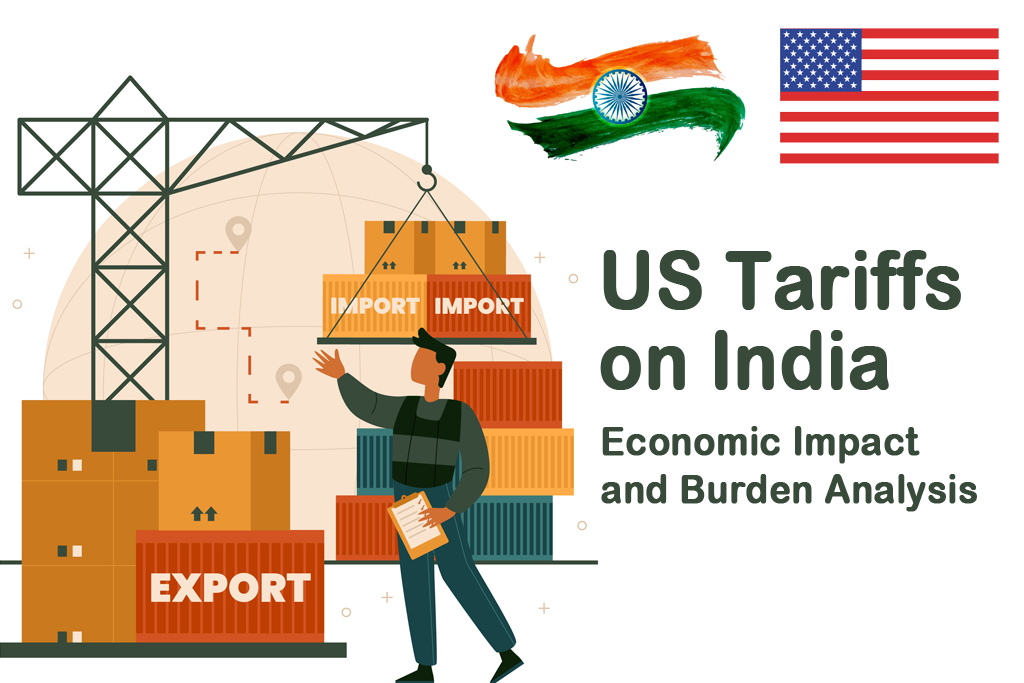Today, On August 1, 2025, the United States implemented a 25% tariff on all goods imported from India, accompanied by an unspecified penalty tied to India’s trade relations with Russia. This policy, announced by US President Donald Trump, targets India’s $87 billion export market to the US, its largest trading partner, with bilateral trade valued at $190 billion in 2024. The tariffs aim to address perceived trade imbalances and India’s purchases of Russian oil and military equipment, which the US views as supporting Russia’s actions in Ukraine. For India, a nation reliant on exports for economic growth, this development has raised significant concerns about its economic stability and global trade position.
This article provides a comprehensive analysis of India’s concerns regarding the US tariffs, evaluates the economic impact on both nations, and determines who bears the ultimate economic loss. Drawing from recent developments, official statements, and economic research, the analysis offers insights for stakeholders navigating this complex trade landscape.
Table of Contents
India’s Concerns Over US Tariffs
India’s reaction to the US tariffs reflects deep concern, as the policy threatens its export-driven economy and broader growth objectives. The following points outline the key reasons for India’s worry:
Economic Threat to Exports
The US is India’s largest export market, with $87 billion in goods exported in 2024. The 25% tariff, effective August 1, 2025, makes Indian products costlier, potentially reducing demand. Sectors such as automobiles, auto parts, steel, aluminum, smartphones, electronics, marine products, gems and jewelry, and food categories are particularly vulnerable. The Times of India reports that Indian officials are actively studying the implications, with Commerce Minister Piyush Goyal engaging exporters to assess the impact and prioritize the welfare of farmers, entrepreneurs, and micro, small, and medium enterprises (MSMEs).
GDP Growth Risks
Economic analysts have warned of a potential slowdown in India’s growth due to the tariffs. Icra, a credit rating agency, revised its GDP forecast for India from 6.5% to 6.2% for the current financial year, citing the tariffs’ adverse effects. Nomura estimated a 0.2% GDP hit, highlighting the risk to export-oriented industries. These projections underscore the broader economic implications, particularly as India aims to achieve a $500 billion bilateral trade target with the US by 2030.
Strategic and Diplomatic Challenges
India is exploring strategies to mitigate the tariffs’ impact, such as increasing imports of US goods like natural gas, communication equipment, and gold to narrow its $44.4 billion trade surplus with the US. However, these measures may not fully offset export losses. India is also committed to negotiating a bilateral trade agreement (BTA) with the US, targeting completion of the first stage by October-November 2025. The tariffs, seen as a negotiating tool, add pressure to these discussions, with the US citing India’s high tariffs (12% trade-weighted average compared to the US’s 2.2%) and Russia trade ties as justifications.
Domestic Political Pressure
The tariffs have intensified domestic political scrutiny. The Congress party has criticized the Modi government, labeling the situation a “catastrophic failure of foreign policy.” This reflects the high stakes for India’s leadership in managing economic and diplomatic fallout, further amplifying the government’s concern.
India’s proactive response—studying impacts, engaging stakeholders, and pursuing diplomacy—demonstrates its commitment to safeguarding national interests. However, the immediate threat to exports and growth remains a pressing issue.
Economic Impact on India
The US tariffs have both immediate and long-term economic implications for India, affecting specific sectors and the broader economy.
Sector-Specific Impacts
The tariffs target several key Indian export sectors, with varying degrees of impact:
| Sector | Export Value to US (2024) | Tariff Rate | Estimated Impact |
|---|---|---|---|
| Automobiles & Auto Parts | $2.6 billion (3%) | 25% | $0.13–0.78 billion loss |
| Electronics | $10.05 billion (13%) | 27% | $0.5–3 billion loss |
| Gems & Jewelry | $9 billion | 25–27% | Significant market and margin erosion |
| Steel & Aluminum | Data Not Available | 25–27% | Reduced competitiveness |
| Marine Products | Data Not Available | 25–27% | Potential demand reduction |
| Pharmaceuticals | $8 billion (10%) | Exempt | No immediate impact |
| Semiconductors | Data Not Available | Exempt | Strategic relief |
- Automobiles and Auto Parts: Representing 3% of US exports, this sector faces a potential loss of $0.13–0.78 billion due to reduced demand.
- Electronics: With $10.05 billion in exports, a 27% tariff could lead to losses of $0.5–3 billion, impacting smartphone and electronics manufacturers.
- Gems and Jewelry: Annual exports of $9 billion are at risk, with potential market erosion due to higher costs and competition from lab-grown diamonds.
- Exempt Sectors: Pharmaceuticals ($8 billion) and semiconductors are exempt, providing strategic relief due to their importance in global supply chains.
Broader Economic Effects
- GDP Impact: The tariffs could reduce India’s GDP by 0.2–0.5% if they persist through FY26, affecting export-driven regions in western and southern India.
- Currency and Markets: The Indian rupee weakened to a four-month low post-announcement, and stock markets saw volatility, particularly in IT, auto, and chemical sectors.
- MSME Vulnerability: Export-driven MSMEs face significant risks, as higher costs could lead to reduced sales and job losses.
- Competitive Positioning: India’s 26% tariff rate is lower than China’s (54%), Taiwan’s (32%), and Vietnam’s (46%), potentially allowing partial market retention in chemicals, processed foods, and garments.
Long-Term Implications
Prolonged tariffs could hinder India’s ambition to become a global manufacturing hub, as businesses may shift to countries with lower tariffs, such as Vietnam or Bangladesh. However, India’s domestic-driven economy, with exports to the US accounting for only 2% of GDP, may cushion some impacts. The Finance Ministry projects GDP growth of 6.3–6.8% for FY 2025-26, supported by robust domestic consumption and trade diversification.
Economic Impact on the United States
The tariffs also have significant implications for the US economy, primarily affecting consumers and businesses.
Consumer and Business Costs
- Higher Prices: US consumers will face increased costs for Indian imports, contributing to an estimated $1,270 tax increase per household in 2025, rising to $1,619 in 2026. This reflects higher prices for goods like electronics, apparel, and food.
- Inflation Risks: Tariffs on food imports, including from India, could drive higher food prices, exacerbating inflation.
Economic Efficiency
- GDP Reduction: The Tax Foundation estimates a 0.8% reduction in long-run US GDP due to all tariffs, with Section 232 tariffs contributing 0.2% and IEEPA tariffs (if upheld) 0.6%. Retaliation could further reduce GDP by 0.2%.
- Job Losses: The tariffs could result in 142,000 job losses, with retaliation adding another 27,000.
Government Revenue
- Tariff Revenue: Over 2025–2034, tariffs are projected to generate $2.4 trillion in conventional revenue ($1.7 trillion dynamically), with $167.7 billion in 2025 alone. However, retaliation could reduce revenue by $132 billion.
Trade Deficit
While the tariffs aim to reduce the US trade deficit with India ($45.7 billion in 2024), they may not succeed. Higher tariffs could reduce imports but also prompt retaliation, affecting US exports.
Who Bears the Ultimate Loss?
Determining who bears the ultimate loss requires analyzing the immediate and long-term impacts on both nations.
India’s Losses
- Immediate Exporter Impact: Indian exporters in affected sectors will face reduced demand and lower margins, with potential losses of $0.5–3 billion in electronics and $0.13–0.78 billion in automobiles. MSMEs are particularly vulnerable, risking job losses and reduced revenues.
- GDP Growth: A 0.2–0.5% GDP reduction could slow economic progress, particularly in export hubs.
- Strategic Setbacks: India’s goal to rival China as a manufacturing hub could be undermined if businesses relocate to lower-tariff countries.
US Losses
- Consumer Burden: Higher prices for Indian goods will increase living costs, with a $1,270–$1,619 tax increase per household over 2025–2026.
- Economic Inefficiency: A 0.8% GDP reduction and 142,000 job losses reflect broader economic costs, with retaliation exacerbating these impacts.
- Trade Risks: Retaliatory tariffs on $330 billion of US exports could harm American exporters, negating trade deficit reduction efforts.
Both nations are likely to share the economic burden, with India facing immediate export losses and the US experiencing indirect consumer and efficiency costs. The extent of the loss depends on:
- Duration of Tariffs: Short-term tariffs may cause temporary disruptions, but prolonged tariffs could lead to a trade war, harming both economies.
- Negotiation Outcomes: A successful BTA by fall 2025 could reduce tariffs to 15–20%, mitigating losses. Failure to reach a deal could exacerbate economic damage.
Comparative Analysis
| Aspect | India’s Loss | US’s Loss |
|---|---|---|
| Immediate Impact | Reduced export revenues, job losses in MSMEs, weakened rupee | Higher consumer prices, potential inflation |
| Economic Indicators | GDP reduction of 0.2–0.5%, market volatility | GDP reduction of 0.8%, 142,000 job losses |
| Sectors Affected | Automobiles, electronics, gems, steel, marine products | Consumers across imported goods, food sector |
| Long-Term Implications | Loss of manufacturing competitiveness, trade diversion to competitors | Reduced economic efficiency, risk of retaliation affecting exporters |
Conclusion and Implications
India is justifiably concerned about the US tariffs, as they threaten its $87 billion export market and economic growth. The immediate impact on exporters, particularly in automobiles, electronics, and gems, is significant, with potential GDP losses of 0.2–0.5%. India’s proactive measures—boosting US imports, negotiating a BTA, and leveraging its domestic-driven economy—aim to mitigate these effects, but challenges remain.
The ultimate economic loss is shared, with Indian exporters bearing direct costs through reduced sales and US consumers facing higher prices, contributing to a $1,270–$1,619 household tax increase. Both nations risk economic slowdowns, with the US facing a 0.8% GDP reduction and India a smaller but significant hit. The outcome hinges on trade negotiations, with a potential deal offering relief and prolonged tariffs risking a trade war.
Stakeholders should monitor ongoing BTA talks, expected to progress by fall 2025, and prepare for potential retaliatory measures. India’s resilience, driven by domestic demand and strategic exemptions, provides some buffer, but exporters and US consumers remain the primary bearers of the tariffs’ burden.
References
- Times of India: Donald Trump Tariffs News Live Updates
- BusinessToday: Explained: What Trump’s 25% Tariff and Russia-Linked Penalty Means for India
- ClearTax: Reciprocal Tariffs 2025: Impact on India’s US Export Trade
- Tax Foundation: Trump Tariffs: The Economic Impact of the Trump Trade War
- Reuters: Trump Says US, India Still Negotiating After 25% US Tariff Threat
- India Today: US Imposes 25% Tariff on India: What It Means for Exports and Key Sectors
- EY India: Key Highlights of US Tariff’s Impact with Respect to the Consumer and Retail Sectors
- IndMoney: How US Tariffs Impacts Indian Stock Market?
- The Global Statistics: India Tariffs on United States 2025







